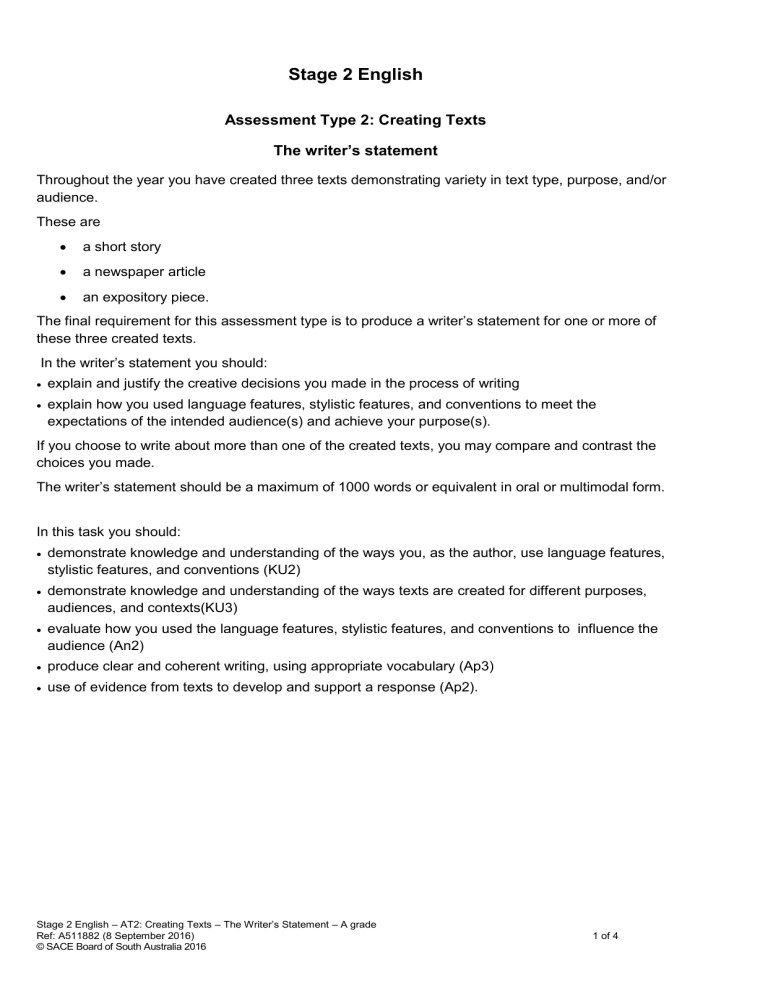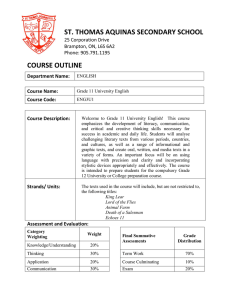
Stage 2 English Assessment Type 2: Creating Texts The writer’s statement Throughout the year you have created three texts demonstrating variety in text type, purpose, and/or audience. These are a short story a newspaper article an expository piece. The final requirement for this assessment type is to produce a writer’s statement for one or more of these three created texts. In the writer’s statement you should: explain and justify the creative decisions you made in the process of writing explain how you used language features, stylistic features, and conventions to meet the expectations of the intended audience(s) and achieve your purpose(s). If you choose to write about more than one of the created texts, you may compare and contrast the choices you made. The writer’s statement should be a maximum of 1000 words or equivalent in oral or multimodal form. In this task you should: demonstrate knowledge and understanding of the ways you, as the author, use language features, stylistic features, and conventions (KU2) demonstrate knowledge and understanding of the ways texts are created for different purposes, audiences, and contexts(KU3) evaluate how you used the language features, stylistic features, and conventions to influence the audience (An2) produce clear and coherent writing, using appropriate vocabulary (Ap3) use of evidence from texts to develop and support a response (Ap2). Stage 2 English – AT2: Creating Texts – The Writer’s Statement – A grade Ref: A511882 (8 September 2016) © SACE Board of South Australia 2016 1 of 4 The following text is one of the three texts the student would have created for this text type. The writer’s statement is about this one text. Stage 2 English – AT2: Creating Texts – The Writer’s Statement – A grade Ref: A511882 (8 September 2016) © SACE Board of South Australia 2016 2 of 4 For one of my text production pieces I chose to write a descriptive piece as I was inspired by an old photo of my father and his horse waiting for a herd of cattle during a muster. My purpose was to capture the contrast between my father’s wise and tender personality and his weathered appearance. I decided that to achieve this I had to portray the harsh world in which he worked and lived for many years and the impact it has had on him. I made an assumption that my audience would be unlikely to have firsthand experience of the environment of the Australian bush so I used language and stylistic features such as adjectives and figurative language to create interest in my piece and make it easier for the reader to relate to. Imagery such as the ‘ragged horizon’ in the first line creates a picture of a large but untamed area and contributes more than just the literal meanings of the two words. I also demonstrated the kind and gentle nature of my father’s personality through the compassion he shows his horse as he is ’resting against her forehead with his comforting hand’ and through the descriptions of his eyes as ‘smoky blue, weathered by the land, but aged with wisdom’. I chose a descriptive form to write about my father as it creates a greater connection to an unfamiliar character and evokes emotional reactions from the reader. I wrote my piece with a tone of admiration and emphasised my father’s strength and resilience by using harsh adjectives and consonants such as; ‘the sun bore down’, ‘red, dusty land’ and the ‘feverish heat’ when describing his surroundings. By portraying an unforgiving environment I demonstrated to the reader how such harsh elements have permanently weathered his body but not his determination. I also emphasised the ‘rugged exterior’ though alliteration such as the ‘furrows of his face’. This was paired with the personification of time as something that was ’creeping up on him’ to render the feeling that everything about the environment is against him, giving the reader further reason to respect my father because of his ability to remain strong, regardless. Another common convention of descriptive writing is to appeal to all of the senses of the reader in much the same way a poet might. I used the range of senses including the smell of the environment as my father filled the air with the ‘musty smell of tar’ and the sounds of the ‘distant rumble of stampeding hooves’ to paint a picture in the reader’s mind. Focusing on the small, intricate details of the description such as the ‘cracked and crevassed’ feet is another convention I employed throughout the piece to create an image for the reader. I also chose to describe his boots that were decaying from over use to exaggerate his body’s persistence against the daily demands. By describing his worn out boots I highlighted the fact that his feet were stronger, emphasising his toughness and resilience against the bush. I also felt that it was important for his feet to be included in my descriptive piece as he is renowned for never wearing his shoes. I tried to portray his hatred for shoes and how his feet have consequently suffered because of it. Through the in inclusion of his horse in the description I was able to expose his tender side. I used an animal to show the inner kindness of my father because animals generally evoke empathetic emotions in a reader. By highlighting my father’s love for his companion through gestures and soft spoken reassurance I captured the sensitivity of my father, a complete juxtaposition to the rugged image I had created throughout the rest of the piece. Eyes are very personal and are one of the most expressive features in the human face and where the emotion can be detected. Because of this I chose to use my father’s eyes as another way of expressing his kindness to the reader. I chose the metaphor of his eyes being ’windows into the soul’ because it emphasized the image and presented the reader with another way of considering what eyes can represent. My intended audience was mature readers who have had little to no experience on the land. While my descriptive piece is slightly stereotypical of a ‘rugged’ old jackaroo, I felt that through contrasting descriptions I was able to create a deeper understanding of the man underneath all that blood, sweat and dust. (751 words) Stage 2 English – AT2: Creating Texts – The Writer’s Statement – A grade Ref: A511882 (8 September 2016) © SACE Board of South Australia 2016 3 of 4 Performance Standards for Stage 2 English - Knowledge and Understanding Analysis Application A Comprehensive knowledge and understanding of ideas and perspectives in a range of texts. Complex analysis of ideas, perspectives, and/or aspects of culture represented in texts. Thorough knowledge and understanding of the ways in which creators of texts use a range of language features, stylistic features, and conventions to make meaning. Perceptive analysis of language features, stylistic features, and conventions used in texts, and thoughtful evaluation of how these influence audiences. Versatile and precise use of language and stylistic features to create a wide range of coherent texts that address the purpose, audience, and context. Extensive knowledge and understanding of a wide range of ways in which texts are created for different purposes, audiences, and contexts. Critical analysis of similarities and differences when comparing texts. Sophisticated use of accurate, clear, and fluent expression. Knowledge and understanding of ideas and perspectives in a range of texts. Detailed analysis of ideas, perspectives, and/or aspects of culture represented in texts. Accurate use of language and stylistic features to create a range of coherent texts that address the purpose, context, and audience. B Knowledge and understanding of the ways in which creators of texts use a range of language features, stylistic features, and conventions to make meaning. C Knowledge and understanding of a range of ways in which texts are created for different purposes, contexts, and audiences. Clear analysis of similarities and differences when comparing texts. Knowledge and understanding of some ideas and perspectives in texts. Analysis of some ideas and perspectives represented in texts. Knowledge and understanding of the ways in which creators of texts use some language features, stylistic features, and conventions to make meaning. Knowledge and understanding ways in which everyday texts are created for different purposes, contexts, and audiences. D Description and some analysis of different language features, stylistic features, and conventions, and/or some evaluation of how these influence audiences. Description of some ideas in texts. Some knowledge and understanding of the ways in which creators of texts use language features and conventions to make meaning. Description of some language features, stylistic features, and/or conventions. Description of some similarities and differences in texts. Identification of an idea in a text. Reference to an idea in a text. Identification of a limited range of ways in which creators of texts use language techniques. Recognition of language or stylistic features. Recognition of one or more ways in which a familiar text is created. Appropriate use of evidence from texts to develop and support a response. Consistent use of accurate, clear, and fluent expression. Generally accurate use of language and stylistic features to create texts that address the purpose, context, and audience. Selection of some evidence from texts to develop and support a response. Appropriate use of accurate, clear, and fluent expression. Analysis of some similarities and differences when comparing texts. Knowledge and understanding of some ideas in a narrow range texts. Knowledge and understanding of ways in which some everyday texts are created for different purposes and audiences. E Detailed analysis of language features, stylistic features, and conventions, and evaluation of how these influence audiences. Fluently integrated use of evidence from texts to develop and support a response. Recognition of a simple connection between texts. Stage 2 English – AT2: Creating Texts – The Writer’s Statement – A grade Ref: A511882 (8 September 2016) © SACE Board of South Australia 2016 Use of some language and stylistic features to create a narrow range of texts. Partial use of basic evidence from texts to develop a response. Inconsistent use of expression. Restricted use of language or stylistic features to create a text. Limited use of evidence from a text in a response. Limited use of clear expression. 4 of 4




